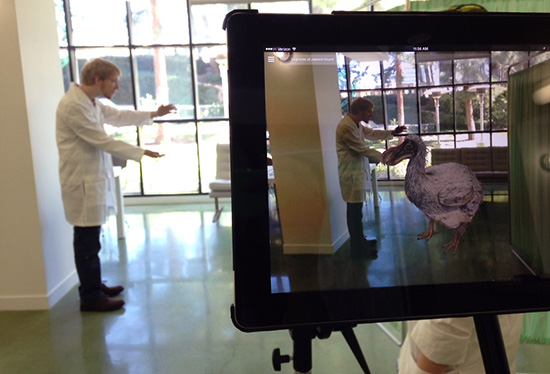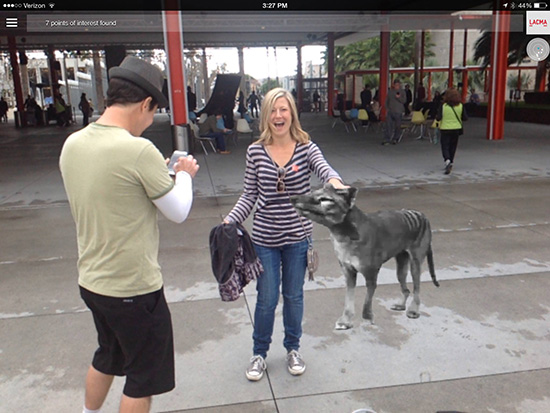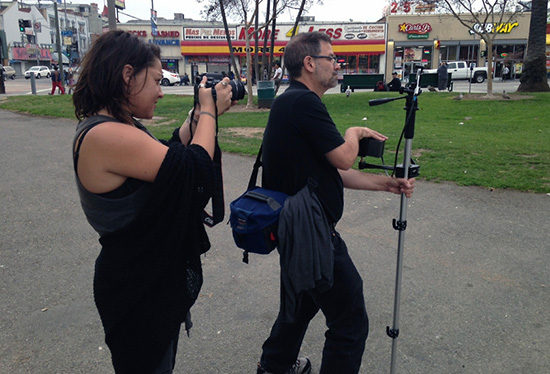Freeman brings augmented reality to ELA

Mike Anderson '15, an Emerson College Los Angeles student of Professor J. Craig Freeman, is participating in an augmented reality project with the Los Angeles County Museum of Art. (Photo by Haley Lannon '15)
New media artist and Visual and Media Arts Professor John Craig Freeman spoke about art, technology, and his citywide augmented reality virtual art project EEG AR: Things We Have Lost during a lecture at Emerson College Los Angeles on March 16.
“As a public artist, I’m interested in the idea of emergent technologies,” said Freeman. “I’m always looking for new forms of public art.”
The free public lecture began with a history of the Los Angeles County Museum of Art’s (LACMA) Art & Technology Lab. Chris DeFay, a board adviser for the lab, discussed LACMA’s original Art and Technology program, which ran from 1967 to 1971. The program paired technology companies in Southern California with artists such as Andy Warhol, James Turrell, and Robert Irwin, among others.
“The idea was to recruit companies with materials and personnel that might be used by artists to open up new art forms,” said DeFay.
Inspired by its history, LACMA launched the Art & Technology Lab in 2013 and issued a call for grant proposals that engage emerging technology. Freeman, whose project utilizes electroencephalography (brainwave sensing) and augmented reality (a live view of a real-world environment augmented by a computer), was a recipient of one of the grants.
EEG AR: Things We Have Lost is based on a project Freeman worked on in Liverpool, England. For the project, Freeman ventured into the city and asked people what they had lost, recording their answers on video. After making a database of the lost objects, he used augmented reality and geolocation to place the objects where he had interviewed the individuals. The result: a city full of lost objects people can see on their phones or tablets.

“The database of lost objects becomes kind of a portrait of the city itself,” said Freeman. “What the city chooses to remember or not to remember.”
In Los Angeles, Freeman and his ELA students conduct the same types of interviews, using a technology called photogrammetry to create a 3-D virtual object based on the individuals’ responses. He also makes avatars of the people interviewed, placing them with the objects. A team of students in Boston works on making the avatars responsive.
“The cool thing is that anyone can view the project on their phone,” said Michael Anderson ’15, a Visual and Media Arts major who is interning for Freeman. “It’s very public and open.”

Professor J. Craig Freeman and his student Lucianna Farone Coccia '15 doing field work for the augmented reality project at MacArthur Park in Los Angeles. (Photo by Haley Lannon '15)
Freeman said that because students are required to engage directly with people, he has seen many of them come out of their shells. Another byproduct of the project is that it has bolstered the connection between Emerson College in Boston and Los Angeles.
“My students in Boston and LA meet once a week in the Di Bona Distance Learning Center,” said Freeman. “The project has really allowed me to delve into bicoastal teaching.”
A second part of the project at the Art & Technology Lab involves brainwave sensors. When members of the public are hooked up to the sensors, their concentration levels change when they are asked the question “What have you lost?” The idea is that once an individual’s attention level goes up, his or her brainwaves will trigger a call to the lost objects database and a random object will appear in front of the person on an iPad.
“The individual is thinking the object into existence,” said Freeman.
Asked how he might respond to a question about what he’s lost, Freeman said “home.”
“I was born here in LA, but it’s not at all the same place I left,” said Freeman, who grew up in San Diego and moved around a lot growing up.
Freeman said that responses to the question about what people have lost run the gamut—from the very trivial to the very profound. Answers have included keys, a skateboard, compassion for the human species, and family.
“There’s an interesting story to every single one of the lost things,” Freeman said.
Categories